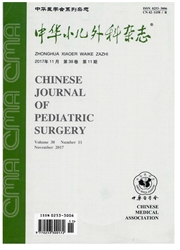

 中文摘要:
中文摘要:
目的分析DIXDC1和AXIN2基因在先天性巨结肠症(hirschsprung disease,HSCR)中的表达,探讨其在HSCR中的意义。方法采用蛋白印迹(Western blot)、免疫组化和荧光实时定量PCR(quantitative rea1-timePCR,qRT-PCR)方法检测60例HSCR患儿正常段(有神经节段肠管)和狭窄段(无神经节段肠管)中DIXDC1和AXIN2的表达,并对其表达进行定量与比较分析。结果DIⅪ)C1和AxIN2在HSCR狭窄段肠管中蛋白相对表达量为27.16±2.04和29.63±4.72,高于正常段肠管中的13.27±3.15和14.99±2.82,差异有统计学意义(DIⅪ)C1P〈O.041;AXIN2P〈0.035)。DIXDC1和AXIN2在HSCR狭窄段肠壁的肌间和黏膜下细胞胞质内呈强阳性反应,而在HSCR正常段肠壁的肌间和黏膜下细胞胞质内呈弱阳性或阴性。DIⅪ)C1和Ax1N2在HSCR狭窄段肠管中mRNA相对含量为22.34±1.23和25.77±2.06,高于正常段肠管中的12.53±1.47和13.98±1.62,差异有统计学意义(DIXDC1P〈O.033;AXIN2P〈O.029)。结论DIXDC1和AXIN2mR—NA与蛋白在HSCR肠管组织中的异常表达,可能与HSCR的发生关系密切,并可能在先天性消化道畸形的肠道发育中起一定作用。
 英文摘要:
英文摘要:
Objective To study the expression of DIXDC1 and AXIN2 gene in tissue samples from the patients with Hirschsprung disease (HSCR) and validate their significane in HSCR. Methods Western blot, immunohistochemical staining and real-time quantitative PCR (qRT-PCR) methods were done in 60 cases of HSCR patients at the normal segment (ganglion section of bowel) and the stenotic segment (absence of ganglion section of bowel) for DIXDC1 and AXIN2 expression. Results The protein expression of DIXII and AXIN2 in stenotic segment were 27. 16 ± 2. 04 and 29. 63 ± 4. 72,as compared to normal segment (13.27 ± 3.15 and 14. 99 ± 2. 82). The difference was statistically significant (DIXDC 1 P〈0. 041 and AXIN2 P〈0. 035). In the myenteric ganglia, the submucosa,muscle and longitudinal muscle of ganglionic segment, immunohistochemical staining of DIXDC1 and AXIN2 were detected with low expression. High expression of these were found in aganglionic segment. The mRNA expression of DIXDC1 and AXIN2 were 22. 34 ± 1.23 and 25.77 ± 2. 06 respectively in stenotic segment, and they were higher than normal segment (12, 53 ± 1.47 and 13.98 ±1.62). The difference was also statistically significant (DIXDC 1 P〈0. 043; AXIN2 P〈0. 039). Concluslons DIXX21 and AXIN2 genes and protein expression were higher in aganglionic segments in HSCRo This would suggest that DIXDC1 and AXIN2 were involved in the formation stages of HSCR, and may play a role in the pathogenesis congenital malformation of the alimentary tract.
 同期刊论文项目
同期刊论文项目
 同项目期刊论文
同项目期刊论文
 Spatiotemporal expression of Wnt5a during the development of the striated muscle complex in rats wit
Spatiotemporal expression of Wnt5a during the development of the striated muscle complex in rats wit Reduced Wnt3a expression correlates with poor development of the hindgut in rats with anorectal malf
Reduced Wnt3a expression correlates with poor development of the hindgut in rats with anorectal malf 期刊信息
期刊信息
